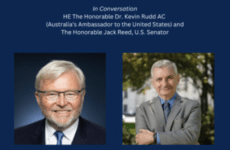By: Justine Axelsson
Posted In: Entertainment

Photo credit: Justine Axelsson
Sandy Nesbitt, owner of Blink Gallery, stands before some of his photographs.
Sandy Nesbitt is a Newport photographer and gallery owner who strives for authenticity and meaning in his photographs and combines the need to make a living with the desire to travel the world.
Alexander (Sandy) Nesbitt spent his childhood in Newport and after high school he attended the Pratt Institute in Brooklyn, N.Y. He went to college for a degree in engineering and physics, but switched his major to sculpture before he decided on photography. What started out as a minor interest and some photo classes soon became his niche. Nesbitt has traveled around the world including most of Eastern and Southern Africa, a large number of countries in the Middle East, and all European countries excluding Spain and Portugal. He has also been to Cuba, Mexico, Syria, and all over the Caribbean. Nesbitt was awarded the “Travel Photographer of the Year Award” for his photography taken abroad. In June 2001, Nesbitt moved into a new studio/gallery on Thames Street, which he called Blink Gallery. The gallery boasts “fresh and contemporary photography,” taken by Nesbitt and occasionally featuring the work of other artists. Blink Gallery is the home to most of Nesbitt’s work and many prints that are available in sizes ranging from 5 X 7 to 16 X 24, and his pictures sell from $32 to $465. In his free time, Nesbitt is a world travel addict. He also enjoys kite-boarding, which is a popular Newport sport, dancing, and teaching his mom, a wood block artist, his skills in photography. As a photographer, Nesbitt emphasizes the importance of authentic photographs that leave a lot to the imagination and give viewers a glimpse into the world of his subjects, many of which are people engulfed in their various cultures. Nesbitt feels that the meaning and content of his photographs is not fully understood by the Newport crowd, so to appeal to their taste he uses local scenery in many of his photographs as well.Q. Where do you take most of your photographs, locally or abroad?
A. “Slightly more of my work comes from foreign travel. I feel that my better stuff comes from overseas but the people here don’t really get it. I get more requests for Newport pictures; however, I am much more productive when I go away, and there are no interruptions.”
Q. What does most of your subject matter seem to be?
A. “I would say it is a split between landscapes and people. Landscapes are meditative and serene, and they are easier to take. Photographing people takes really quick thinking, but it’s more fun. With people, you have to be conscious of their personal space, feelings, and the situation. I think the photographs of people are more interesting because people react to people more.”
Q. I know you received “Travel Photographer of the Year Award.” Can you tell me a little about what that award is?
A. “The award has only existed for about two years. I won the ‘Spirit of Adventure” and the “Natural World” categories. The ideas were adventure, the natural world and environment, cities, and people in their culture. The photographs were entered in sets of four and were coordinated into various subjects. I won with my set called “desert trek in Egypt” which was basically a 10 day walk in the sand, and I won for photographs of a leatherback turtle, and a waterfall.
Q. What makes a photograph “good” to you?
A. “There are so many variables, it’s hard to say. There are two main things. The first is what’s in the picture. What’s it about? The other is, do the shapes in the picture work? What makes them great is if both things are functioning together. I sort of have trouble with serene and sentimental images because I like colors, big shapes, and boldness. Then main thing I prefer is that the picture is authentic. I can’t stand fake sentimentality and fake nostalgia.”
Q. What is it about the way you photograph that sets you apart from others in the same field?
A. “I’m really a documentation photographer. All my pictures are real situations. I’m trying to show that what I photograph is actually out there and that I have found it. I spend a lot of mental effort thinking about how certain parts of the picture complement other parts and I choose what to crop and what to leave in. I try to communicate something in a photo through having control over contextual images.” (As he explains this, Nesbitt shows me a photograph of a man opening a huge gate designed like skulls and crossbones and explains the importance of the man at that exact moment to that photograph).
Q. Do you have a favorite photograph?
A. “Soul Alley” would have to be my favorite. It is a picture taken in Antigua of a man strolling down an empty alley. The street twinkled a bluish color, and the way the man was walking and swinging his arms made it seem like he was dancing. Again the concept of the contextual imagery is important and the picture wouldn’t be the same without the street signs that say “Soul Alley” and “High St.” with an arrow pointing upward.”
Q. Is it difficult to run a gallery in a small town that is so set in its ways?
A. “It’s been tricky to keep running a gallery here instead of in the city where anything goes. The Newport audience doesn’t really get the meaning in my photography, but I like being here because I like choosing to be a little less commercialized.














